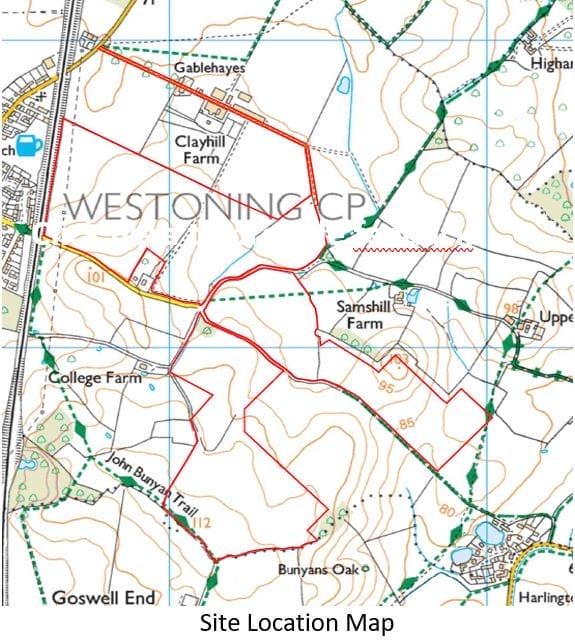The Sampshill Solar Farm Project
Development of a 43.45 MW solar park on land at Sampshill Road, Westoning, MK45 5AD.
Anesco Limited is proposing to develop a 43.45 MW solar farm on the land at Sampshill Road, Westoning, MK45 5AD.
The proposal involves the construction and operation of a solar installation that will connect into the local electricity network, comprising solar modules, solar inverters and associated works, including landscaping.
The grid connection location and substation location is shown in the North area of the site. All cabling associated with the grid connection will be underground. The application area will be approximately 66 hectares and planning permission will be sought for a period of 40 years.
In response to an Environmental Impact Assessment (EIA) screening request, Central Bedfordshire Council adopted a screening opinion on 11th January 2021 concluding that the proposal is not an EIA development (ref:CB/20/04581/SCN)
More information
To access site maps and plans click on the links below:
We are now seeking views from residents on the proposal as laid out in this leaflet.
Unfortunately, due to the restrictions from the Covid-19 pandemic, we are unable to host a public consultation event in person within the local town of Westoning, we do however encourage feedback and any queries or questions via our Contact Us section. Closing date for receipt of feedback is 30th April 2021.
Climate change emergency
In June 2019, the UK government became the first major economy in the world to pass laws to end its contribution to global warming by 2050.
What this means is that by that date, the UK’s greenhouse gas emissions will be carbon neutral. Creating a better environment now, and for generations to come.
Carbon neutral is about finding a balance between the total greenhouse gas emissions being produced, and the total emissions being removed from the environment. This commitment to becoming carbon neutral is a substantial increase on the UK’s previous target and comes at a time when pressure is building on governments to recognise and take urgent action in light of the climate emergency.
Central Bedfordshire adopted a sustainability plan outlining the steps for the council to be carbon neutral by 2030 and is aiming to achieve a 25% carbon reduction by 2023.
About solar technology
Solar is the most popular renewable technology in the world and is an incredibly clean source of renewable energy. Unlike other renewable technologies, solar panels have no moving parts and therefore operate silently. They are also low in height and can be hidden behind hedgerows or fencing, minimising the visual impact on the landscape.
The Sampshill solar project
The Sampshill solar project is expected to power approximately 11,300 average UK homes. Furthermore, the project is expected to generate 42600 MWh per annum which is anticipated to save 10,000 tonnes of CO2 equivalent emissions per annum. Projects of this kind also present biodiversity enhancement opportunities. The site is not located within an AONB (Area Outstanding Natural Beauty), National Park or other designated landscape area, and is away from heritage designations and features.
The solar farm would be set back from residential properties, which would limit views of the development within the local area. A full landscape and visual impact assessment will be completed, and it is anticipated that further planting and hedgerow re-enforcement will be put in place. Anesco has engaged with the local parish councils and also welcome opportunities to engage with local schools to provide tours of the solar farm in future.
Biodiversity enhancements
The RSPB ‘State of Nature Report’ highlights the severity of the decline in British wildlife. It details that of the 8,431 species that have been assessed using regional Red List criteria, 15% have been classified as threatened with extinction from Great Britain. Climate change is driving widespread changes in the abundance, distribution, and ecology of the UK’s wildlife, and will continue to do so for decades or even centuries to come.
Solar farms present an excellent opportunity for biodiversity. The proposed solar farm will be installed on piles with minimal disturbance to the ground. The solar panels have no moving parts and the infrastructure typically disturbs less than 5% of the ground. The posts upon which the panels are mounted take up less than 1% of the land area. Because panels are raised above the ground on posts, more than 95% of a solar farm field area is still accessible for plant growth and potentially for wildlife enhancements. The proposed solar farm would have a lifespan of 40 years which is sufficient time for appropriate land management to yield real wildlife and biodiversity improvements within the local area.
A site-specific biodiversity plan will be devised to cover the lifetime of the proposed solar farm, working closely with the ecologists, and conservation organisations to ensure that the biodiversity enhancements are most appropriate to the local area.
FEEDBACK
The deadline for feedback is 30th April 2021
THANK YOU

Clean green technology
Supports biodiversity
Saving 10,000 tonnes of CO2 per annum
Powering 11,300 homes



